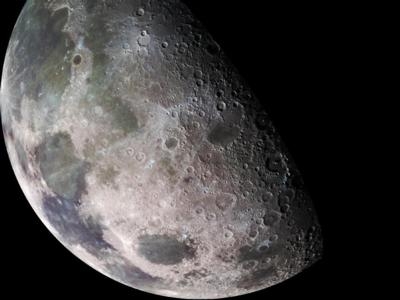Moon's Magnetic Field Lasted For About A Million Years, Scientists Say
The moon no longer has a magnetic field, but NASA scientists are publishing new research that shows heat from crystallization of the lunar core may have driven its now-defunct magnetic field some 3 billion years ago.

Magnetized lunar rocks returned to Earth during the Apollo missions established that the moon once had a magnetic field. The moon’s magnetic field lasted for more than a billion years and, at one point, it was as strong as the one generated by modern Earth. Scientists believe that a lunar dynamo -- a molten, churning core at the center of the moon -- may have powered the magnetic field, but previously did not understand how it had been generated and maintained.
In a paper recently published in Earth and Planetary Science Letters, scientists in the Astromaterials Research and Exploration Science (ARES) Division at NASA’s Johnson Space Center in Houston argue that this dynamo was caused by crystallization of the lunar core.
“Our work ties together physical and chemical constraints and helps us understand how the moon acquired and maintained its magnetic field — a difficult problem to tackle for any inner solar system body,” said Kevin Righter, the first author of the study and JSC’s high pressure experimental petrology lab lead.
According to the paper, the moon likely had an iron/nickel core with only a small amount of sulfur and carbon, thus giving the lunar core a high melting point. As a result, the lunar core likely started crystallizing early in lunar history, and the heat released by crystallization may have driven an early magnetic field that is recorded in ancient lunar samples.
“We created several synthetic core compositions based on the latest geochemical data from the moon, and equilibrated them at the pressures and temperatures of the lunar interior,” Righter said.
A magnetic field has been recorded in lunar samples as young as 3.1 billion years old, but is currently inactive, indicating that at some point between then and now, the heat flow declined to a point where the lunar dynamo became inactive. The lunar core is currently thought to be composed of a solid inner and liquid outer core, known from Apollo seismic and other geophysical and spacecraft data. The new specific lunar core composition proposed by the ARES group likely would be partially solid and liquid today, consistent with the seismic and geophysical data.
The ARES scientists prepared powders of iron, nickel, sulfur and carbon based on geochemical proportion estimates of the moon from recent analyses of Apollo samples. Once prepared, the powders were encapsulated and heated under pressures corresponding to those in the lunar interior. Because the moon may have experienced high temperatures in its early history and lower temperatures during later cooling, the scientists investigated a wide range of temperatures.
Detailed compositions and textures of the solids and liquids formed at the higher pressure and temperature conditions were examined.
Before these new results, the conundrum was that modelling of the moon involved an iron/nickel core with sulfur contents so high (and melting point so low) that crystallization would not have occurred until very late in lunar history. Thus the source of the heat flow out of the core required to drive a dynamo was unclear.
Various sources were proposed such as heat from impact or shear forces. The ARES research team acknowledges that such sources may be real, but if the heat from crystallization of the outer core is available, it is a simple and straightforward, source for a lunar dynamo and would fit well with the expected timing.
“The ARES team is excited because this work shows that a specific geochemically-derived composition can explain many geophysical aspects of the lunar core,” says co-author Lisa Danielson.
(Source: NASA news release. Image from file)
 ANN's Daily Aero-Term (05.29.25): Terminal Radar Service Area
ANN's Daily Aero-Term (05.29.25): Terminal Radar Service Area ANN's Daily Aero-Term (05.30.25): Very High Frequency (VHF)
ANN's Daily Aero-Term (05.30.25): Very High Frequency (VHF) Aero-News: Quote of the Day (05.30.25)
Aero-News: Quote of the Day (05.30.25) Airborne 05.23.25: Global 8000, Qatar B747 Accepted, Aviation Merit Badge
Airborne 05.23.25: Global 8000, Qatar B747 Accepted, Aviation Merit Badge ANN's Daily Aero-Linx (05.30.25)
ANN's Daily Aero-Linx (05.30.25)



